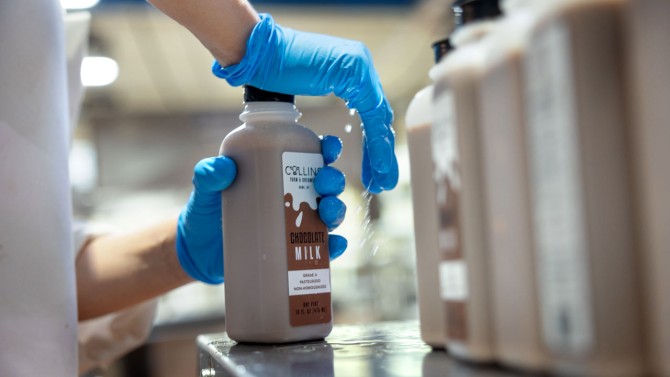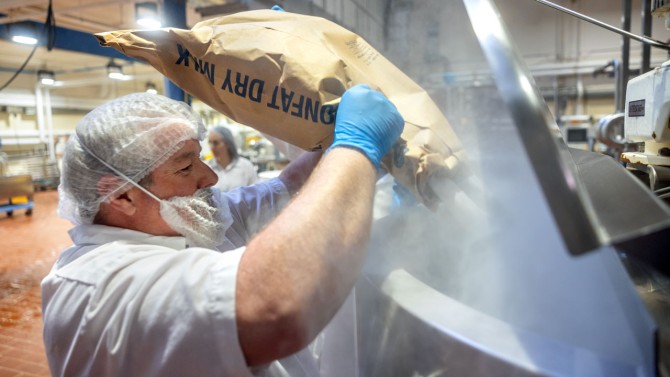
Rebecca Phillips, left, a regional dairy processing specialist with Cornell Dairy Foods Extension, helps John and Sammi Collins bottle their new high-protein chocolate milk drink in Cornell’s Food Processing and Development Laboratory.
Dairy innovation program nurtures the cream of the crop
By Laura Reiley, Cornell Chronicle
For Sammi and John Collins, the spark of innovation was born of hardship. After the pandemic shuttered schools and restaurants, their milk co-op said it would pay for only 85% of the milk they had been shipping. So they started thinking about what else they could do with unsold milk.
They thought of adding a high-protein drink to their lineup of products. A high-protein, not-super-sweet chocolate milk drink with a clean label and local pedigree checked a lot of boxes: A post-workout beverage, something limited-ingredient for locavores seeking a new source of protein, maybe even a better-for-you treat for kids that parents could feel OK about.
But they were going to need guidance and expert help to bring it to market.
The Collinses are participants in the second cohort of Cornell’s Dairy Runway Program, which offers free entrepreneurship training for early stage innovators aiming to launch new dairy products.
“What makes Dairy Runway exceptional is that it layers practical prototype training in a world-class dairy production facility on top of best-in-class entrepreneurship fundamentals and bespoke business development mentorship,” said Jenn Smith, who leads food and agriculture startup programs for Cornell's Center for Regional Economic Advancement. She said participants leave fueled with the knowledge and recipes needed to launch sustainable companies based on innovative dairy products that consumers seek.
The dairy industry is New York state’s largest agricultural sector, generating nearly half of the state’s total agricultural receipts. And it’s boom times for dairy, with the world’s demand steadily rising. But it’s not necessarily traditional liquid milk. As countries develop, the demand for milk drops and enthusiasm for cheese and other products skyrockets. The cheese category has grown 19% since 2017, according to Mintel’s Future of Cheese report. Millennials and Gen Z drink far less liquid milk than previous generations – but yogurt, cheese, ice cream and other “value-added” products are red hot.
“Our first one is going to be chocolate, and we have ideas for additional flavors,” Sammi Collins said. The key for her was going to be packaging and marketing, areas in which traditional animal dairy has lagged in recent years, she said.
“Look at most modern marketing from milk – it’s nothing compared to plant-based products, with their colorful packaging,” she said. “People buy with their eyes, so we want this to be fun. We’re going to try to make milk sexy.”
Her hope, she said, is to formulate a product that allows them to “target consumers who want to know their farmer, value wellness and appreciate whole foods,” but that starts with packaging, and marketing, that is inviting.
But first, a more pressing issue: They had to deal with a clog.
Rebecca Phillips, a regional dairy processing specialist with Cornell Dairy Foods Extension, sat on a milk crate, a milk bucket poised to capture the chocolatey deluge as she uncoupled a spigot from the small pasteurizer in the Food Processing and Development Laboratory.
The nonfat milk powder they were using to add protein to the dairy-based high-protein energy drink was clumping up. For the next trial run, they would premix the nonfat milk powder, sugar and chocolate before combining it with the liquid whole milk and heating it to 155 degrees Fahrenheit. Sammi Collins, cloaked in lab coat, hairnet and rubber gloves, wondered aloud if the mixture would flow through the plate cooler back at Collins Farm & Creamery, their dairy farm in Rome, New York.
The Dairy Runway Program will help the couple overcome logistical challenges like this, but it also helps participants develop a bigger-picture understanding of the marketplace and supply and demand.
For Ken Rother, who teaches entrepreneurship at Cornell SC Johnson College of Business, the dairy runway program, and much of the work he does at Cornell, is “very Socratic” – a dialogue between students and teachers to question beliefs and road-test suppositions.
“Stage One is asking what assumptions they are making about the market, and we ask them to come up with ways of validating those assumptions,” Rother said. “We ask who is the customer for the product and what are the benefits they are looking for. We ask them what holes they see in the marketplace, and where they fit in that space.”
Rother says the program is especially helpful in that all 10 teams are doing work in adjacent areas, so instruction, conversation and even basic spitballing benefits everyone.
For Phillips, who teaches courses on food safety, yogurt-making and ice-cream making, for those aiming to launch products, it’s often the minutiae that matters: If you make a nutrition claim like “high protein,” you have to back it up with data. The number of grams and the percent daily value must be listed on foods’ Nutrition Facts label, something health-minded consumers scrutinize. If your product has added sugars, how little can you get away with and not compromise on the sensory experience?
While Phillips worked with the Collinses on their formulation, Rob Ralyea, a senior extension associate with Cornell Dairy Foods Extension who manages the Food Processing and Development Laboratory, kept watch over the pasteurizer. For low-temperature, long-time pasteurization, his team took the milk beverage up past 150 degrees for 30 minutes, the air space above it even warmer, in order to assure all pathogenic bacteria are killed. On the wall two ink styluses charted real-time temperatures on a wheel of paper referred to as a pasteurization chart recorder.
Ralyea has worked with many of the dairy runway teams, helping to hone and formulate a product for market. He’s helped make alcohol-infused fudge, a flavored creamer, a Mexican-style soft cheese, Greek yogurts – some, he said, “are more viable than others.”
Phillips and Sammi Collins got into a groove, Phillips filling bottles and Collins popping lids on with audible snaps in the busy lab. They would take home 100 pints – 50 of them with about 26 grams of protein each, 50 with even higher protein – in order to taste-test it with friends and family.
On the second-to-last bottle, the team encountered another clog, requiring more spigot disassembly and equipment sanitizing. Whether for jet planes, fashion models or dairy farmers, runways can have their bumps.
Media Contact
Get Cornell news delivered right to your inbox.
Subscribe



